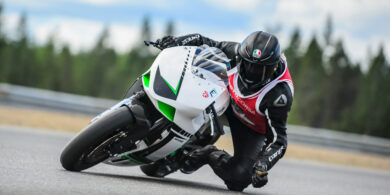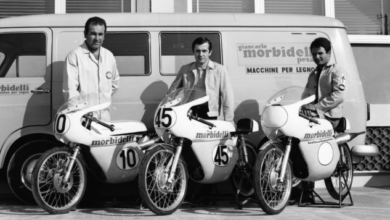Feb. 9, 2009 – A ‘blip’ on the UTV sales chart
By Neil Pascale
Editor
Probably for the first time in its short existence, the UTV market is looking at either a flat or down year in retail sales.
This after the category of side-by-side quads had represented the brightest spot for the industry in terms of higher-end vehicles for a number of quarters.
“They’re nothing like they were last year,” Larry Fuller, general manager of Grand Valley Powersports, Grand Junction, Colo., said of the multibrand dealership’s side-by-side sales. “You can definitely tell there is a difference.”
He’s not alone.
Arctic Cat and Kawasaki officials both point to an overall softer side-by-side segment, one that had experienced double-digit percentage point increases in recent years. Yamaha, which had yet to report on its year end at press time, had said its side-by-side sales were down 5 percent after the first half of the year.
Polaris, however, reports continued growth for its Ranger and RZR lines. In its year-end financial report, Polaris officials said side-by-side sales grew in excess of 35 percent over the year-ago period. That percentage gain did shrink in the fourth quarter, however. Polaris reported its retail sales gains in the final quarter were up in the mid-single digits compared to 2007’s fourth quarter.
‘starting to get some steam’
Arctic Cat and Kawasaki officials are both quick to point to this UTV sales year as a “blip” in an otherwise growing segment.
“It really was only starting to get some steam when this economic calamity happened,” Vince Iorio, Kawasaki Motors Corp. U.S.A. product manager, said of the UTV market. “I know it’s not setting back our product development and I know it’s not setting back our desires to increase market share, come with new products and find the new products that customers want.”
John Tranby, Arctic Cat’s communications and marketing manager, agreed.
“I think once things (the U.S. economy) clean up a little bit, I think it will still grow, maybe at the expense of some of the ATV business,” he said. “But it seems to be a very popular model for a move-up or even a first-timer who has property.”
Polaris officials, however, said in their fourth-quarter financial report they expect the core ATV and UTV businesses to slow in 2009, with much more modest declines in the side-by-side segment. Several OEM officials point to the challenges in financing, rather than a lagging interest, for the stabilizing or softening of UTV sales.
“We didn’t get into it because we thought it had already peaked and gone away,” Bill Savino, manager of motorcycle press for American Honda Motor Co., said of the UTV market.
Honda has had its MUV (multipurpose utility vehicle), the Big Red, out in the market for the past five months and is still adding dealers.
“We studied the market very heavily for many, many years and we got into it at a later date,” Savino said. “But we also came into it, we believe, very strong. We came in with a MUV vs. a sport machine and we came into it with a little different attitude than the other OEs. We came into it in the typical Honda way: With an innovative product that’s unique to the industry and targeted to a specific consumer. Feedback from the media and customers reflect that we came in with a very good product. And the dealerships that are selling it (Big Red) have been really positive about it so far.”
Kawasaki’s Teryx, its recreational side-by-side offering, also is relatively new to the market, having been out about a year now.
“We were pleasantly surprised at how the year ended up,” Iorio said, noting despite the economic challenges Kawasaki still sold about 85 percent of the units it had planned on selling. “We had a steamroller of interest in the product in the fall because it had been out seven or eight months in the market. The aftermarket was ramping up and people were realizing how sturdy, how durable it is.”
Kawasaki has noticed the recreational part of the UTV market is relatively flat, rather than showing the tremendous growth that was seen in the past couple of years.
“The sense is from the sales department that the market is not expanding, it’s stagnant,” Iorio said. “So obviously we’re taking units (market share) away from somebody.”
Also relatively stagnant is the utility side of the side-by-side business as Iorio reported fairly flat numbers for Kawasaki’s Mule line. As in prior years, the company’s lowest displacement machine, its 400cc, is still a top-seller in the Mule lineup.“It’s pretty popular because you have people who don’t want to spend or can’t spend over $9,000 and they get into a nice, little four-wheel drive and it’s quite a capable vehicle for very little money,” Iorio said.
Easing fears
Arctic Cat is hoping its largest-displacement Prowler, which just started shipping weeks ago, will energize sales for the second half of its fiscal year. “You’re seeing a lot more movement in product innovations in the side-by-sides right now so we continue to look at it as a growth movement,” Tranby said of the UTV segment. “We’re looking at this blip as one of these weird anomalies that occur.”
Kawasaki’s Iorio points to a number that has come from initial Teryx buyers data that should ease any fears about a possible long-term slowdown in UTV sales. More than 60 percent of Teryx buyers are new to powersports, meaning the segment continues to draw plenty of excitement from those not associated with the industry.
“When you see a figure of over 60 percent new to powersports, you get a pretty good feeling in your stomach,” he said. “Once the economy recovers, I think the UTV market is poised for additional growth, even if it might be stagnant right now.”




